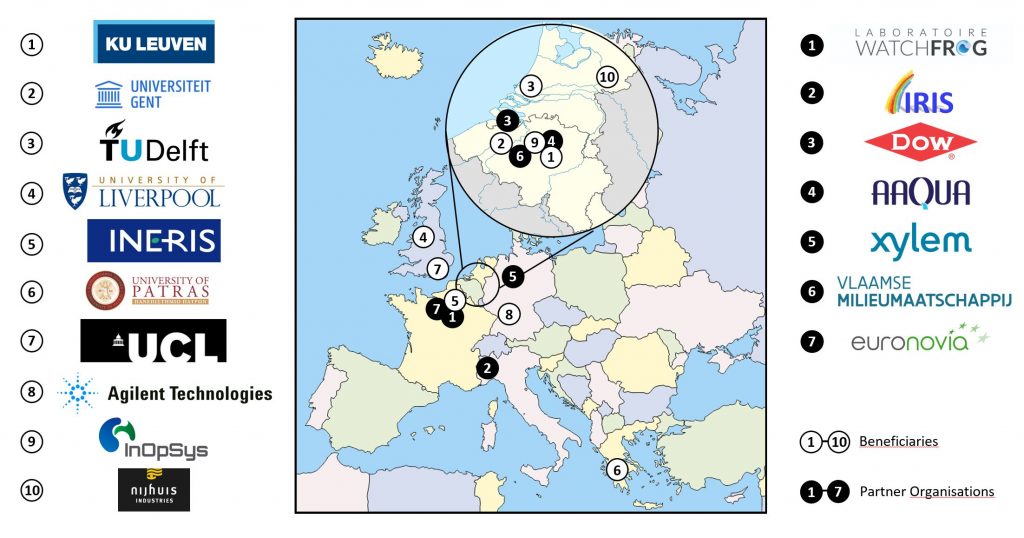The overarching aim of the InnovEOX project is to provide high-level training in emerging wastewater treatment techniques to a new generation of high-achieving early stage researchers to provide them with the transferable and scientific skills necessary for thriving careers in a burgeoning area. This international training program, combining 10 beneficiaries and 7 partner organisations from 7 countries, focuses on innovative technological developments across a range of interdisciplinary fields such as electrochemical oxidation techniques in wastewater treatment, advanced analytical chemistry and toxicity assessment. The aim of this project will be achieved by a unique combination of intersectoral research training, facilitated by the diverse academic/non-academic composition of the consortium.
InnovEOX deals with a topic of growing worldwide societal concern: the contamination of natural water resources with emerging pollutants. Freshwater is increasingly endangered by organic chemical pollutants from human activities that threaten the ecosystem and biodiversity. Some of the most important pollutants have been delineated as priority substances by the European Commission as they represent a significant risk to or via the aquatic environment. These substances are regulated by the EU Water Framework Directive as a strategy against the advancing pollution of water. The EU water policy sets the quality standards for the pollutants to be released into the receiving water bodies. Furthermore, the REACH regulation also impacts by setting up specific requirements for chemical pollutants. Despite these efforts of regulation, data collected on more than 200 pollutants from 4000 monitoring sites throughout 91 European river basins, demonstrate that organic chemical pollutants are still putting half of the European freshwater ecosystems at risk. On more than 500 of the sites monitored, concentrations were found in quantities likely to cause mortality of fish, invertebrate and algae species. Therefore, besides pollution-prevention recommendations, the European Environment Agency (EEA) encourages the upstream chemical treatment of unavoidable (industrial) effluents as these effluents are significant paths through which chemical water pollution enters the aquatic environment (“Science for Environment Policy”: European Commission DG Environment News Alert Service, 2015).
A class of treatment technologies, overall termed Advanced Oxidation Processes (AOP), is receiving high attention for the degradation of these hazardous pollutants from wastewater because of their distinct advantages compared to conventional technologies, the most important one being that they effectively degrade recalcitrant components without generating a secondary waste stream as is the case for, e.g., membrane processes. AOPs are based predominantly on the production of highly reactive hydroxyl radicals (OH*) for the oxidation of pollutants in water. However, despite great advancements that have been made in this technology during the last few decades, AOPs can still be adversely affected by several factors including the complexity of the water matrix, the type and concentration of the contaminant, the type and concentration of the oxidants and catalysts, and the reactor configuration. This highlights the need for additional developments to overcome these limitations. An increasing focus is now being laid on electrochemical AOPs (eAOPs), which are very attractive in this regard, since they are chemical-free, do not produce waste, operate at ambient temperature and pressure, and can be powered by a renewable energy source. As described in this proposal, InnovEOX will feature a 4 years research training program to develop highly innovative advances in eAOPs. Research towards this technology development should moreover go hand in hand with innovations in the accurate assessment of the safety and toxicity of the treated water. Since a wide spectrum of degradation products is prone to be produced, a full chemical evaluation and toxicity assessment is required to guarantee the safe application of eAOP water treatment, hence necessitating the development of novel state-of-the-art analytical techniques.

InnovEOX Consortium: 10 Beneficiaries and 7 Partner Organisations
 InnovEOX Innovative Electrochemical OXidation Processes for the Removal and Analysis of micro-pollutants in water streams
InnovEOX Innovative Electrochemical OXidation Processes for the Removal and Analysis of micro-pollutants in water streams